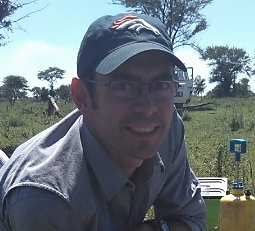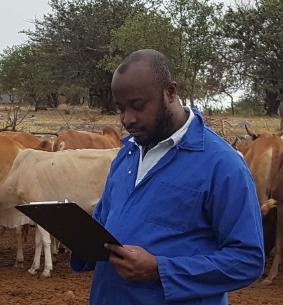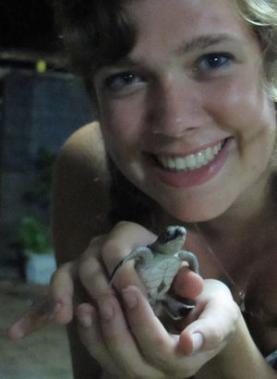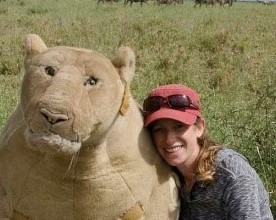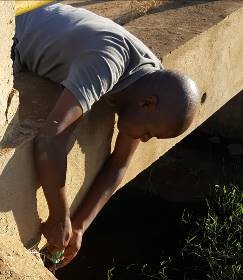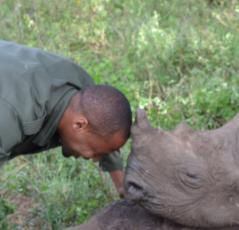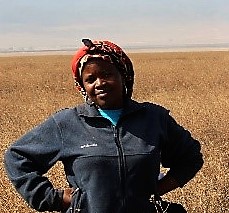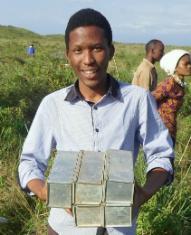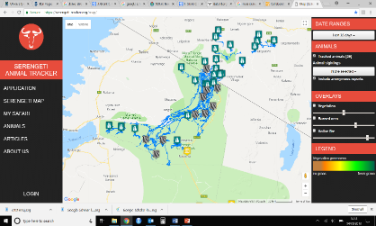Number of items: 76.
2025
Mellya, R. V.K. et al.
(2025)
Natural dispersal is better than translocation for reducing risks of inbreeding depression in eastern black rhinoceros (Diceros bicornis michaeli).
Proceedings of the National Academy of Sciences of the United States of America, 122(23),
e241441212.
(doi: 10.1073/pnas.2414412122)
Schwandner, I. A. et al.
(2025)
Predicting the impact of targeted fence removal on connectivity in a migratory ecosystem.
Ecological Applications, 35(1),
e3094.
(doi: 10.1002/eap.3094)
Kavwele, Cyrus M.  ORCID: https://orcid.org/0000-0003-4619-515X, Hopcraft, J. Grant C.
ORCID: https://orcid.org/0000-0003-4619-515X, Hopcraft, J. Grant C.  ORCID: https://orcid.org/0000-0002-9617-9951, Morales, Juan M.
ORCID: https://orcid.org/0000-0002-9617-9951, Morales, Juan M.  ORCID: https://orcid.org/0000-0001-7269-7490, Nyafi, Gerald, Kimuya, Nancy and Torney, Colin J.
ORCID: https://orcid.org/0000-0001-7269-7490, Nyafi, Gerald, Kimuya, Nancy and Torney, Colin J.  ORCID: https://orcid.org/0000-0003-1673-7835
(2025)
Real‐time classification of Serengeti wildebeest behaviour with edge machine learning and a long‐range IoT network.
Canadian Journal of Zoology, 103,
pp. 1-11.
(doi: 10.1139/cjz-2024-0075)
ORCID: https://orcid.org/0000-0003-1673-7835
(2025)
Real‐time classification of Serengeti wildebeest behaviour with edge machine learning and a long‐range IoT network.
Canadian Journal of Zoology, 103,
pp. 1-11.
(doi: 10.1139/cjz-2024-0075)
2024
Masolele, Majaliwa M., Hopcraft, J. Grant C.  ORCID: https://orcid.org/0000-0002-9617-9951 and Torney, Colin J.T.
ORCID: https://orcid.org/0000-0002-9617-9951 and Torney, Colin J.T.  ORCID: https://orcid.org/0000-0003-1673-7835
(2024)
Efficient approximate Bayesian inference for quantifying uncertainty in multiscale animal movement models.
Ecological Informatics, 84,
102853.
(doi: 10.1016/j.ecoinf.2024.102853)
ORCID: https://orcid.org/0000-0003-1673-7835
(2024)
Efficient approximate Bayesian inference for quantifying uncertainty in multiscale animal movement models.
Ecological Informatics, 84,
102853.
(doi: 10.1016/j.ecoinf.2024.102853)
Kavwele, Cyrus M.  ORCID: https://orcid.org/0000-0003-4619-515X, Hopcraft, J. Grant C.
ORCID: https://orcid.org/0000-0003-4619-515X, Hopcraft, J. Grant C.  ORCID: https://orcid.org/0000-0002-9617-9951, Davy, Deborah and Torney, Colin J.
ORCID: https://orcid.org/0000-0002-9617-9951, Davy, Deborah and Torney, Colin J.  ORCID: https://orcid.org/0000-0003-1673-7835
(2024)
Automated and repeated aerial observations of GPS‐collared animals using UAVs and open‐source electronics.
Ecosphere, 15(4),
e4841.
(doi: 10.1002/ecs2.4841)
ORCID: https://orcid.org/0000-0003-1673-7835
(2024)
Automated and repeated aerial observations of GPS‐collared animals using UAVs and open‐source electronics.
Ecosphere, 15(4),
e4841.
(doi: 10.1002/ecs2.4841)
Anderson, T. M. et al.
(2024)
Interplay of competition and facilitation in grazing succession by migrant Serengeti herbivores.
Science, 383(6684),
pp. 782-788.
(doi: 10.1126/science.adg0744)
(PMID:38359113)
Kabalika, Zabibu  ORCID: https://orcid.org/0000-0001-7181-5088, Haydon, Daniel T.
ORCID: https://orcid.org/0000-0001-7181-5088, Haydon, Daniel T.  ORCID: https://orcid.org/0000-0002-1240-1886, McGill, Rona A.R.
ORCID: https://orcid.org/0000-0002-1240-1886, McGill, Rona A.R.  ORCID: https://orcid.org/0000-0003-0400-7288, Morales, Juan M.
ORCID: https://orcid.org/0000-0003-0400-7288, Morales, Juan M.  ORCID: https://orcid.org/0000-0001-7269-7490, Morrison, Thomas A.
ORCID: https://orcid.org/0000-0001-7269-7490, Morrison, Thomas A.  ORCID: https://orcid.org/0000-0001-7262-1402, Newton, Jason
ORCID: https://orcid.org/0000-0001-7262-1402, Newton, Jason  ORCID: https://orcid.org/0000-0001-7594-3693 and Hopcraft, J. Grant C.
ORCID: https://orcid.org/0000-0001-7594-3693 and Hopcraft, J. Grant C.  ORCID: https://orcid.org/0000-0002-9617-9951
(2024)
Using sulfur stable isotope ratios (δ34S) for animal geolocation: estimating the delay mechanisms between diet ingestion and isotope incorporation in tail hair.
Rapid Communications in Mass Spectrometry, 38(2),
e9674.
(doi: 10.1002/rcm.9674)
ORCID: https://orcid.org/0000-0002-9617-9951
(2024)
Using sulfur stable isotope ratios (δ34S) for animal geolocation: estimating the delay mechanisms between diet ingestion and isotope incorporation in tail hair.
Rapid Communications in Mass Spectrometry, 38(2),
e9674.
(doi: 10.1002/rcm.9674)
Kabalika, Zabibu  ORCID: https://orcid.org/0000-0001-7181-5088, Haydon, Daniel T.
ORCID: https://orcid.org/0000-0001-7181-5088, Haydon, Daniel T.  ORCID: https://orcid.org/0000-0002-1240-1886, McGill, Rona A.R.
ORCID: https://orcid.org/0000-0002-1240-1886, McGill, Rona A.R.  ORCID: https://orcid.org/0000-0003-0400-7288, Morales, Juan M.
ORCID: https://orcid.org/0000-0003-0400-7288, Morales, Juan M.  ORCID: https://orcid.org/0000-0001-7269-7490, Morrison, Thomas A.
ORCID: https://orcid.org/0000-0001-7269-7490, Morrison, Thomas A.  ORCID: https://orcid.org/0000-0001-7262-1402, Newton, Jason
ORCID: https://orcid.org/0000-0001-7262-1402, Newton, Jason  ORCID: https://orcid.org/0000-0001-7594-3693 and Hopcraft, J. Grant C.
ORCID: https://orcid.org/0000-0001-7594-3693 and Hopcraft, J. Grant C.  ORCID: https://orcid.org/0000-0002-9617-9951
(2024)
Using sulfur stable isotope ratios (δ34S) for animal geolocation: Estimating the delay mechanisms between diet ingestion and isotope incorporation in tail hair.
Rapid Communications in Mass Spectrometry, 38(2),
e9674.
(doi: 10.1002/rcm.9674)
(PMID:38124168)
ORCID: https://orcid.org/0000-0002-9617-9951
(2024)
Using sulfur stable isotope ratios (δ34S) for animal geolocation: Estimating the delay mechanisms between diet ingestion and isotope incorporation in tail hair.
Rapid Communications in Mass Spectrometry, 38(2),
e9674.
(doi: 10.1002/rcm.9674)
(PMID:38124168)
2023
Donaldson, J. E. et al.
(2023)
Direct and indirect effects of fire on parasites in an African savanna.
Journal of Animal Ecology, 92(12),
pp. 2323-2332.
(doi: 10.1111/1365-2656.14013)
Ekwem, Divine, Enright, Jessica  ORCID: https://orcid.org/0000-0002-0266-3292, Hopcraft, J. Grant C.
ORCID: https://orcid.org/0000-0002-0266-3292, Hopcraft, J. Grant C.  ORCID: https://orcid.org/0000-0002-9617-9951, Buza, Joram, Shirima, Gabriel, Shand, Mike
ORCID: https://orcid.org/0000-0002-9617-9951, Buza, Joram, Shirima, Gabriel, Shand, Mike  ORCID: https://orcid.org/0000-0002-0085-4896, Mwajombe, James K., Bett, Bernard, Reeve, Richard
ORCID: https://orcid.org/0000-0002-0085-4896, Mwajombe, James K., Bett, Bernard, Reeve, Richard  ORCID: https://orcid.org/0000-0003-2589-8091 and Lembo, Tiziana
ORCID: https://orcid.org/0000-0003-2589-8091 and Lembo, Tiziana  ORCID: https://orcid.org/0000-0002-6405-1849
(2023)
Local and wide-scale livestock movement networks inform disease control strategies in East Africa.
Scientific Reports, 13,
9666.
(doi: 10.1038/s41598-023-35968-x)
(PMID:37316521)
(PMCID:PMC10267211)
ORCID: https://orcid.org/0000-0002-6405-1849
(2023)
Local and wide-scale livestock movement networks inform disease control strategies in East Africa.
Scientific Reports, 13,
9666.
(doi: 10.1038/s41598-023-35968-x)
(PMID:37316521)
(PMCID:PMC10267211)
Tucker, M. A. et al.
(2023)
Behavioral responses of terrestrial mammals to COVID-19 lockdowns.
Science, 380(6649),
pp. 1059-1064.
(doi: 10.1126/science.abo6499)
(PMID:37289888)
Wu, Z. et al.
(2023)
Deep learning enables satellite-based monitoring of large populations of terrestrial mammals across heterogeneous landscape.
Nature Communications, 14,
3072.
(doi: 10.1038/s41467-023-38901-y)
(PMID:37244940)
(PMCID:PMC10224963)
Torney, Colin J.  ORCID: https://orcid.org/0000-0003-1673-7835, Laxton, Megan, Lloyd‐Jones, David J., Kohi, Edward M., Frederick, Howard L., Moyer, David C., Mrisha, Chediel, Mwita, Machoke and Hopcraft, J. Grant C.
ORCID: https://orcid.org/0000-0003-1673-7835, Laxton, Megan, Lloyd‐Jones, David J., Kohi, Edward M., Frederick, Howard L., Moyer, David C., Mrisha, Chediel, Mwita, Machoke and Hopcraft, J. Grant C.  ORCID: https://orcid.org/0000-0002-9617-9951
(2023)
Estimating the abundance of a group-living species using multi-latent spatial models.
Methods in Ecology and Evolution, 14(1),
pp. 77-86.
(doi: 10.1111/2041-210x.13941)
ORCID: https://orcid.org/0000-0002-9617-9951
(2023)
Estimating the abundance of a group-living species using multi-latent spatial models.
Methods in Ecology and Evolution, 14(1),
pp. 77-86.
(doi: 10.1111/2041-210x.13941)
Mellya, Ronald V. K., Hopcraft, J. Grant C.  ORCID: https://orcid.org/0000-0002-9617-9951, Eblate, Ernest M., Kariuki, Linus, Otiende, Moses, Chuma, Idrissa S., Macha, Emmanuel S., Wambura, Dickson, Kilbride, Elizabeth and Mable, Barbara K.
ORCID: https://orcid.org/0000-0002-9617-9951, Eblate, Ernest M., Kariuki, Linus, Otiende, Moses, Chuma, Idrissa S., Macha, Emmanuel S., Wambura, Dickson, Kilbride, Elizabeth and Mable, Barbara K.  ORCID: https://orcid.org/0000-0001-7118-4116
(2023)
Mitochondrial DNA diversity of the eastern black rhinoceros (Diceros bicornis michaeli) in Tanzania: implications for future conservation.
Conservation Genetics, 24,
pp. 905-919.
(doi: 10.1007/s10592-023-01545-y)
ORCID: https://orcid.org/0000-0001-7118-4116
(2023)
Mitochondrial DNA diversity of the eastern black rhinoceros (Diceros bicornis michaeli) in Tanzania: implications for future conservation.
Conservation Genetics, 24,
pp. 905-919.
(doi: 10.1007/s10592-023-01545-y)
2022
Paun, Ionut  ORCID: https://orcid.org/0009-0003-1673-9803, Husmeier, Dirk
ORCID: https://orcid.org/0009-0003-1673-9803, Husmeier, Dirk  ORCID: https://orcid.org/0000-0003-1673-7413, Hopcraft, J. Grant C.
ORCID: https://orcid.org/0000-0003-1673-7413, Hopcraft, J. Grant C.  ORCID: https://orcid.org/0000-0002-9617-9951, Masolele, Majaliwa M. and Torney, Colin J.
ORCID: https://orcid.org/0000-0002-9617-9951, Masolele, Majaliwa M. and Torney, Colin J.  ORCID: https://orcid.org/0000-0003-1673-7835
(2022)
Inferring spatially varying animal movement characteristics using a hierarchical continuous-time velocity model.
Ecology Letters, 25(12),
pp. 2726-2738.
(doi: 10.1111/ele.14117)
(PMID:36256526)
ORCID: https://orcid.org/0000-0003-1673-7835
(2022)
Inferring spatially varying animal movement characteristics using a hierarchical continuous-time velocity model.
Ecology Letters, 25(12),
pp. 2726-2738.
(doi: 10.1111/ele.14117)
(PMID:36256526)
Stone, David W., Kelly, Chris, Marneweck, David G., Druce, Dave J., Hopcraft, J. Grant C.  ORCID: https://orcid.org/0000-0002-9617-9951 and Marneweck, Courtney J.
(2022)
Fence management and time since pack formation influence African wild dog escapes from protected areas in South Africa.
Journal for Nature Conservation, 70,
126291.
(doi: 10.1016/j.jnc.2022.126291)
ORCID: https://orcid.org/0000-0002-9617-9951 and Marneweck, Courtney J.
(2022)
Fence management and time since pack formation influence African wild dog escapes from protected areas in South Africa.
Journal for Nature Conservation, 70,
126291.
(doi: 10.1016/j.jnc.2022.126291)
Fryxell, John M., Mduma, Simon, Masoy, Joseph, Sinclair, Anthony R. E., Hopcraft, Grant J.C.  ORCID: https://orcid.org/0000-0002-9617-9951 and Packer, Craig
(2022)
Stabilizing effects of group formation by Serengeti herbivores on predator-prey dynamics.
Frontiers in Ecology and Evolution, 10,
981842.
(doi: 10.3389/fevo.2022.981842)
ORCID: https://orcid.org/0000-0002-9617-9951 and Packer, Craig
(2022)
Stabilizing effects of group formation by Serengeti herbivores on predator-prey dynamics.
Frontiers in Ecology and Evolution, 10,
981842.
(doi: 10.3389/fevo.2022.981842)
Kavwele, Cyrus M.  ORCID: https://orcid.org/0000-0003-4619-515X, Torney, Colin J.
ORCID: https://orcid.org/0000-0003-4619-515X, Torney, Colin J.  ORCID: https://orcid.org/0000-0003-1673-7835, Morrison, Thomas A.
ORCID: https://orcid.org/0000-0003-1673-7835, Morrison, Thomas A.  ORCID: https://orcid.org/0000-0001-7262-1402, Fulford, Sidney, Masolele, Majaliwa M., Masoy, Joseph and Hopcraft, J. Grant C.
ORCID: https://orcid.org/0000-0001-7262-1402, Fulford, Sidney, Masolele, Majaliwa M., Masoy, Joseph and Hopcraft, J. Grant C.  ORCID: https://orcid.org/0000-0002-9617-9951
(2022)
Non‐local effects of human activity on the spatial distribution of migratory wildlife in Serengeti National Park, Tanzania.
Ecological Solutions and Evidence, 3(3),
e12159.
(doi: 10.1002/2688-8319.12159)
ORCID: https://orcid.org/0000-0002-9617-9951
(2022)
Non‐local effects of human activity on the spatial distribution of migratory wildlife in Serengeti National Park, Tanzania.
Ecological Solutions and Evidence, 3(3),
e12159.
(doi: 10.1002/2688-8319.12159)
Baino, Allan A., Hopcraft, Grant G.J.C.  ORCID: https://orcid.org/0000-0002-9617-9951, Kendall, Corinne J. and Newton, Jason
ORCID: https://orcid.org/0000-0002-9617-9951, Kendall, Corinne J. and Newton, Jason  ORCID: https://orcid.org/0000-0001-7594-3693
(2022)
We are what we eat, plus some per mill: using stable isotopes to estimate diet composition in Gyps vultures over space and time.
Ecology and Evolution, 12(3),
e8726.
(doi: 10.1002/ece3.8726)
(PMID:35356581)
(PMCID:PMC8941503)
ORCID: https://orcid.org/0000-0001-7594-3693
(2022)
We are what we eat, plus some per mill: using stable isotopes to estimate diet composition in Gyps vultures over space and time.
Ecology and Evolution, 12(3),
e8726.
(doi: 10.1002/ece3.8726)
(PMID:35356581)
(PMCID:PMC8941503)
Stabach, J. A. et al.
(2022)
Increasing anthropogenic disturbance restricts wildebeest movement across East African grazing systems.
Frontiers in Ecology and Evolution, 10,
846171.
(doi: 10.3389/fevo.2022.846171)
2021
Ekwem, Divine, Morrison, Thomas  ORCID: https://orcid.org/0000-0001-7262-1402, Reeve, Richard
ORCID: https://orcid.org/0000-0001-7262-1402, Reeve, Richard  ORCID: https://orcid.org/0000-0003-2589-8091, Enright, Jessica, Buza, Joram, Shirima, Gabriel, Mwajombe, James K., Lembo, Tiziana
ORCID: https://orcid.org/0000-0003-2589-8091, Enright, Jessica, Buza, Joram, Shirima, Gabriel, Mwajombe, James K., Lembo, Tiziana  ORCID: https://orcid.org/0000-0002-6405-1849 and Hopcraft, J. Grant C.
ORCID: https://orcid.org/0000-0002-6405-1849 and Hopcraft, J. Grant C.  ORCID: https://orcid.org/0000-0002-9617-9951
(2021)
Livestock movement informs the risk of disease spread in traditional production systems in East Africa.
Scientific Reports, 11,
16375.
(doi: 10.1038/s41598-021-95706-z)
(PMID:34385539)
(PMCID:PMC8361167)
ORCID: https://orcid.org/0000-0002-9617-9951
(2021)
Livestock movement informs the risk of disease spread in traditional production systems in East Africa.
Scientific Reports, 11,
16375.
(doi: 10.1038/s41598-021-95706-z)
(PMID:34385539)
(PMCID:PMC8361167)
Kauffman, M. J. et al.
(2021)
Mapping out a future for ungulate migrations.
Science, 372(6542),
pp. 566-569.
(doi: 10.1126/science.abf0998)
(PMID:33958460)
Morrison, T. A. et al.
(2021)
Drivers of site fidelity in ungulates.
Journal of Animal Ecology, 90(4),
pp. 955-966.
(doi: 10.1111/1365-2656.13425)
(PMID:33481254)
2020
Kabalika, Z. et al.
(2020)
Tracking animal movements using biomarkers in tail hairs: a novel approach for animal geolocating from sulfur isoscapes.
Movement Ecology, 8,
37.
(doi: 10.1186/s40462-020-00222-w)
(PMID:32968486)
(PMCID:PMC7501629)
Larsen, Freja, Hopcraft, J. Grant C.  ORCID: https://orcid.org/0000-0002-9617-9951, Hanley, Nick
ORCID: https://orcid.org/0000-0002-9617-9951, Hanley, Nick  ORCID: https://orcid.org/0000-0002-1362-3499, Hongoa, John Reuben, Hynes, Stephen, Loibook, Martin, Mafuru, Gerald, Needham, Katherine and Morrison, Thomas A.
ORCID: https://orcid.org/0000-0002-1362-3499, Hongoa, John Reuben, Hynes, Stephen, Loibook, Martin, Mafuru, Gerald, Needham, Katherine and Morrison, Thomas A.  ORCID: https://orcid.org/0000-0001-7262-1402
(2020)
Wildebeest migration drives tourism demand in the Serengeti.
Biological Conservation, 248,
108688.
(doi: 10.1016/j.biocon.2020.108688)
ORCID: https://orcid.org/0000-0001-7262-1402
(2020)
Wildebeest migration drives tourism demand in the Serengeti.
Biological Conservation, 248,
108688.
(doi: 10.1016/j.biocon.2020.108688)
Hopcraft, J. Grant C.  ORCID: https://orcid.org/0000-0002-9617-9951 and Laurenson, M. Karen
(2020)
Markus Borner, a life at the conservation front line.
Conservation Biology, 34(3),
pp. 769-770.
(doi: 10.1111/cobi.13507)
(PMID:32450619)
ORCID: https://orcid.org/0000-0002-9617-9951 and Laurenson, M. Karen
(2020)
Markus Borner, a life at the conservation front line.
Conservation Biology, 34(3),
pp. 769-770.
(doi: 10.1111/cobi.13507)
(PMID:32450619)
2019
Joly, K. et al.
(2019)
Longest terrestrial migrations and movements around the world.
Scientific Reports, 9,
15333.
(doi: 10.1038/s41598-019-51884-5)
(PMID:31654045)
(PMCID:PMC6814704)
Probert, J. R. et al.
(2019)
Anthropogenic modifications to fire regimes in the wider Serengeti‐Mara ecosystem.
Global Change Biology, 25(10),
pp. 3406-3423.
(doi: 10.1111/gcb.14711)
(PMID:31282085)
(PMCID:PMC6852266)
Veldhuis, M.P., Kihwele, E.S., Cromsigt, J.P.G.M., Ogutu, J.O., Hopcraft, J.G.C.  ORCID: https://orcid.org/0000-0002-9617-9951, Owen-Smith, N. and Olff, H.
(2019)
Large herbivore assemblages in a changing climate: incorporating water dependence and thermoregulation.
Ecology Letters, 22,
pp. 1536-1546.
(doi: 10.1111/ele.13350)
(PMID:31332945)
(PMCID:PMC6851681)
ORCID: https://orcid.org/0000-0002-9617-9951, Owen-Smith, N. and Olff, H.
(2019)
Large herbivore assemblages in a changing climate: incorporating water dependence and thermoregulation.
Ecology Letters, 22,
pp. 1536-1546.
(doi: 10.1111/ele.13350)
(PMID:31332945)
(PMCID:PMC6851681)
Ogutu, Joseph O., Veldhuis, Michiel P., Morrison, Thomas A., Hopcraft, J Grant C.  ORCID: https://orcid.org/0000-0002-9617-9951 and Olff, Han
(2019)
Conservation: Beyond population growth - Response.
Science, 365(6449),
pp. 133-134.
(doi: 10.1126/science.aay3049)
(PMID:31296761)
ORCID: https://orcid.org/0000-0002-9617-9951 and Olff, Han
(2019)
Conservation: Beyond population growth - Response.
Science, 365(6449),
pp. 133-134.
(doi: 10.1126/science.aay3049)
(PMID:31296761)
Torney, Colin J.  ORCID: https://orcid.org/0000-0003-1673-7835, Lloyd-Jones, David J., Chevallier, Mark, Moyer, David C., Maliti, Honori T., Mwita, Machoke, Kohi, Edward M. and Hopcraft, J.G.C.
ORCID: https://orcid.org/0000-0003-1673-7835, Lloyd-Jones, David J., Chevallier, Mark, Moyer, David C., Maliti, Honori T., Mwita, Machoke, Kohi, Edward M. and Hopcraft, J.G.C.  ORCID: https://orcid.org/0000-0002-9617-9951
(2019)
A comparison of deep learning and citizen science techniques for counting wildlife in aerial survey images.
Methods in Ecology and Evolution, 10(6),
pp. 779-787.
(doi: 10.1111/2041-210X.13165)
ORCID: https://orcid.org/0000-0002-9617-9951
(2019)
A comparison of deep learning and citizen science techniques for counting wildlife in aerial survey images.
Methods in Ecology and Evolution, 10(6),
pp. 779-787.
(doi: 10.1111/2041-210X.13165)
Nkwabi, Ally K., Metzger, Kris, Beyers, Rene, Magige, Flora, Mduma, Simon A. R., Hopcraft, J. Grant C.  ORCID: https://orcid.org/0000-0002-9617-9951 and Sinclair, Anthony R. E.
(2019)
Bird community responses to changes in vegetation caused by increasing large mammal populations in the Serengeti woodlands.
Wildlife Research, 46(3),
pp. 256-264.
(doi: 10.1071/WR18001)
ORCID: https://orcid.org/0000-0002-9617-9951 and Sinclair, Anthony R. E.
(2019)
Bird community responses to changes in vegetation caused by increasing large mammal populations in the Serengeti woodlands.
Wildlife Research, 46(3),
pp. 256-264.
(doi: 10.1071/WR18001)
Veldhuis, M. P. et al.
(2019)
Cross-boundary human impacts compromise the Serengeti-Mara ecosystem.
Science, 363(6434),
pp. 1424-1428.
(doi: 10.1126/science.aav0564)
(PMID:30923217)
Behdenna, A. et al.
(2019)
Transmission ecology of canine parvovirus in a multi-host, multi-pathogen system.
Proceedings of the Royal Society of London Series B: Biological Sciences, 286,
20182772.
(doi: 10.1098/rspb.2018.2772)
(PMID:30914008)
(PMCID:PMC6452066)
2018
Rosa, Isabel, Rentsch, Dennis and Hopcraft, J. Grant C.  ORCID: https://orcid.org/0000-0002-9617-9951
(2018)
Evaluating forest protection strategies: A comparison of land-use systems to preventing forest loss in Tanzania.
Sustainability, 10(12),
4476.
(doi: 10.3390/su10124476)
ORCID: https://orcid.org/0000-0002-9617-9951
(2018)
Evaluating forest protection strategies: A comparison of land-use systems to preventing forest loss in Tanzania.
Sustainability, 10(12),
4476.
(doi: 10.3390/su10124476)
Torney, Colin J.  ORCID: https://orcid.org/0000-0003-1673-7835, Hopcraft, J. Grant C.
ORCID: https://orcid.org/0000-0003-1673-7835, Hopcraft, J. Grant C.  ORCID: https://orcid.org/0000-0002-9617-9951, Morrison, Thomas A.
ORCID: https://orcid.org/0000-0002-9617-9951, Morrison, Thomas A.  ORCID: https://orcid.org/0000-0001-7262-1402, Couzin, Iain D. and Levin, Simon A.
(2018)
From single steps to mass migration: the problem of scale in the movement ecology of the Serengeti wildebeest.
Philosophical Transactions of the Royal Society B: Biological Sciences, 373(1746),
20170012.
(doi: 10.1098/rstb.2017.0012)
(PMID:29581397)
(PMCID:PMC5882982)
ORCID: https://orcid.org/0000-0001-7262-1402, Couzin, Iain D. and Levin, Simon A.
(2018)
From single steps to mass migration: the problem of scale in the movement ecology of the Serengeti wildebeest.
Philosophical Transactions of the Royal Society B: Biological Sciences, 373(1746),
20170012.
(doi: 10.1098/rstb.2017.0012)
(PMID:29581397)
(PMCID:PMC5882982)
2016
Blackburn, Sara, Hopcraft, J. Grant C.  ORCID: https://orcid.org/0000-0002-9617-9951, Ogutu, Joseph O., Matthiopoulos, Jason
ORCID: https://orcid.org/0000-0002-9617-9951, Ogutu, Joseph O., Matthiopoulos, Jason  ORCID: https://orcid.org/0000-0003-3639-8172, Frank, Laurence and Singh, Navinder
(2016)
Human-wildlife conflict, benefit sharing and the survival of lions in pastoralist community-based conservancies.
Journal of Applied Ecology, 53(4),
pp. 1195-1205.
(doi: 10.1111/1365-2664.12632)
ORCID: https://orcid.org/0000-0003-3639-8172, Frank, Laurence and Singh, Navinder
(2016)
Human-wildlife conflict, benefit sharing and the survival of lions in pastoralist community-based conservancies.
Journal of Applied Ecology, 53(4),
pp. 1195-1205.
(doi: 10.1111/1365-2664.12632)
Rysava, K.  ORCID: https://orcid.org/0000-0002-3475-931X, McGill, R.A.R.
ORCID: https://orcid.org/0000-0002-3475-931X, McGill, R.A.R.  ORCID: https://orcid.org/0000-0003-0400-7288, Matthiopoulos, J.
ORCID: https://orcid.org/0000-0003-0400-7288, Matthiopoulos, J.  ORCID: https://orcid.org/0000-0003-3639-8172 and Hopcraft, J.G.C
ORCID: https://orcid.org/0000-0003-3639-8172 and Hopcraft, J.G.C  ORCID: https://orcid.org/0000-0002-9617-9951
(2016)
Re-constructing nutritional history of Serengeti wildebeest from stable isotopes in tail hair: seasonal starvation patterns in an obligate grazer.
Rapid Communications in Mass Spectrometry, 130(13),
pp. 1461-1468.
(doi: 10.1002/rcm.7572)
(PMID:27321833)
ORCID: https://orcid.org/0000-0002-9617-9951
(2016)
Re-constructing nutritional history of Serengeti wildebeest from stable isotopes in tail hair: seasonal starvation patterns in an obligate grazer.
Rapid Communications in Mass Spectrometry, 130(13),
pp. 1461-1468.
(doi: 10.1002/rcm.7572)
(PMID:27321833)
Bukombe, John, Senzota, Ramadhani B., Fryxell, John M., Kittle, Andrew, Kija, Hamza, Hopcraft, John Grant C.  ORCID: https://orcid.org/0000-0002-9617-9951, Mduma, Simon and Sinclair, Anthony R.E.
(2016)
Do animal size, seasons and vegetation type influence detection probability and density estimates of Serengeti ungulates?
African Journal of Ecology, 54(1),
pp. 29-38.
(doi: 10.1111/aje.12255)
ORCID: https://orcid.org/0000-0002-9617-9951, Mduma, Simon and Sinclair, Anthony R.E.
(2016)
Do animal size, seasons and vegetation type influence detection probability and density estimates of Serengeti ungulates?
African Journal of Ecology, 54(1),
pp. 29-38.
(doi: 10.1111/aje.12255)
Hopcraft, J. Grant C.  ORCID: https://orcid.org/0000-0002-9617-9951
(2016)
Population regulation and climate change: the future of Africa's antelope.
In: Bro-Jørgensen, Jakob and Mallon, David P. (eds.)
Antelope Conservation: From Diagnosis to Action.
John Wiley & Sons, Ltd., pp. 32-50.
ISBN 9781118409640
(doi: 10.1002/9781118409572.ch3)
ORCID: https://orcid.org/0000-0002-9617-9951
(2016)
Population regulation and climate change: the future of Africa's antelope.
In: Bro-Jørgensen, Jakob and Mallon, David P. (eds.)
Antelope Conservation: From Diagnosis to Action.
John Wiley & Sons, Ltd., pp. 32-50.
ISBN 9781118409640
(doi: 10.1002/9781118409572.ch3)
Torney, Colin J.  ORCID: https://orcid.org/0000-0003-1673-7835, Dobson, Andrew P., Borner, Felix, Lloyd-Jones, David J., Moyer, David, Maliti, Honori T., Mwita, Machoke, Fredrick, Howard, Borner, Markus and Hopcraft, J. Grant C.
ORCID: https://orcid.org/0000-0003-1673-7835, Dobson, Andrew P., Borner, Felix, Lloyd-Jones, David J., Moyer, David, Maliti, Honori T., Mwita, Machoke, Fredrick, Howard, Borner, Markus and Hopcraft, J. Grant C.  ORCID: https://orcid.org/0000-0002-9617-9951
(2016)
Assessing rotation-invariant feature classification for automated wildebeest population counts.
PLoS ONE, 11(5),
e0156342.
(doi: 10.1371/journal.pone.0156342)
(PMID:27227888)
(PMCID:PMC4881999)
ORCID: https://orcid.org/0000-0002-9617-9951
(2016)
Assessing rotation-invariant feature classification for automated wildebeest population counts.
PLoS ONE, 11(5),
e0156342.
(doi: 10.1371/journal.pone.0156342)
(PMID:27227888)
(PMCID:PMC4881999)
2015
Hopcraft, J. Grant C.  ORCID: https://orcid.org/0000-0002-9617-9951
(2015)
Elephants and Savanna Woodland Ecosystems: A Study from Chobe National Park, Botswana. Coordinating Editor: Jelte van Andel. Christina Skarpe, Johan du Toit, and Stein R. Moe (editors) (2014) Wiley‐Blackwell, Oxford, U.K., 328 pages, £75.00/€88.90 (hardcover), ISBN: 978–0–470–67176–4.
Restoration Ecology, 23(6),
pp. 964-965.
(doi: 10.1111/rec.12297)[Book Review]
ORCID: https://orcid.org/0000-0002-9617-9951
(2015)
Elephants and Savanna Woodland Ecosystems: A Study from Chobe National Park, Botswana. Coordinating Editor: Jelte van Andel. Christina Skarpe, Johan du Toit, and Stein R. Moe (editors) (2014) Wiley‐Blackwell, Oxford, U.K., 328 pages, £75.00/€88.90 (hardcover), ISBN: 978–0–470–67176–4.
Restoration Ecology, 23(6),
pp. 964-965.
(doi: 10.1111/rec.12297)[Book Review]
Nugent, Rachel A., Hopcraft, J. Grant C.  ORCID: https://orcid.org/0000-0002-9617-9951, Bigurube, Gerald, Lembeli, James Daudi and Borner, Markus
(2015)
Balancing conservation with national development: a socio-economic case study of the alternatives to the Serengeti Road.
PLoS ONE, 10(7),
e0130577.
(doi: 10.1371/journal.pone.0130577)
(PMID:26200107)
(PMCID:PMC4511738)
ORCID: https://orcid.org/0000-0002-9617-9951, Bigurube, Gerald, Lembeli, James Daudi and Borner, Markus
(2015)
Balancing conservation with national development: a socio-economic case study of the alternatives to the Serengeti Road.
PLoS ONE, 10(7),
e0130577.
(doi: 10.1371/journal.pone.0130577)
(PMID:26200107)
(PMCID:PMC4511738)
Durant, S. M. et al.
(2015)
Developing fencing policies for dryland ecosystems.
Journal of Applied Ecology, 52(3),
pp. 544-551.
(doi: 10.1111/1365-2664.12415)
Hopcraft, J. G. C. et al.
(2015)
Conservation and economic benefits of a road around the Serengeti.
Conservation Biology, 29(3),
pp. 932-936.
(doi: 10.1111/cobi.12470)
(PMID:25711283)
Hopcraft, J. Grant C.  ORCID: https://orcid.org/0000-0002-9617-9951, Holdo, Ricardo M., Mwangomo, Ephraim, Mduma, Simon, Thirgood, Simon J., Borner, Markus, Fryxell, John M., Olff, Han and Sinclair, Anthony R.E.
(2015)
Why are wildebeest the most abundant herbivore in the Serengeti?
In: Sinclair, Anthony R.E., Metzger, Kristine L., Mduma, Simon A.R. and Fryxell, John M. (eds.)
Serengeti IV: Sustaining Biodiversity in a Coupled Human-Natural System.
University of Chicago Press: Chicago.
ISBN 9780226195834
(doi: 10.7208/chicago/9780226196336.001.0001)
ORCID: https://orcid.org/0000-0002-9617-9951, Holdo, Ricardo M., Mwangomo, Ephraim, Mduma, Simon, Thirgood, Simon J., Borner, Markus, Fryxell, John M., Olff, Han and Sinclair, Anthony R.E.
(2015)
Why are wildebeest the most abundant herbivore in the Serengeti?
In: Sinclair, Anthony R.E., Metzger, Kristine L., Mduma, Simon A.R. and Fryxell, John M. (eds.)
Serengeti IV: Sustaining Biodiversity in a Coupled Human-Natural System.
University of Chicago Press: Chicago.
ISBN 9780226195834
(doi: 10.7208/chicago/9780226196336.001.0001)
Viana, M. et al.
(2015)
Dynamics of a morbillivirus at the domestic-wildlife interface: Canine distemper virus in domestic dogs and lions.
Proceedings of the National Academy of Sciences of the United States of America, 112(5),
pp. 1464-1469.
(doi: 10.1073/pnas.1411623112)
(PMID:25605919)
(PMCID:PMC4321234)
Stevenson, T.J. et al.
(2015)
Disrupted seasonal biology impacts health, food security and ecosystems.
Proceedings of the Royal Society of London Series B: Biological Sciences, 282,
20151453.
(doi: 10.1098/rspb.2015.1453)
(PMID:26468242)
(PMCID:PMC4633868)
2014
Hopcraft, J. Grant C.  ORCID: https://orcid.org/0000-0002-9617-9951, Morales, J.M., Beyer, H.L., Borner, Markus, Mwangomo, Ephraim, Sinclair, A.R.E., Olff, Han and Haydon, Daniel T.
ORCID: https://orcid.org/0000-0002-9617-9951, Morales, J.M., Beyer, H.L., Borner, Markus, Mwangomo, Ephraim, Sinclair, A.R.E., Olff, Han and Haydon, Daniel T.  ORCID: https://orcid.org/0000-0002-1240-1886
(2014)
Competition, predation, and migration: individual choice patterns of Serengeti migrants captured by hierarchical models.
Ecological Monographs, 84(3),
pp. 355-372.
(doi: 10.1890/13-1446.1)
ORCID: https://orcid.org/0000-0002-1240-1886
(2014)
Competition, predation, and migration: individual choice patterns of Serengeti migrants captured by hierarchical models.
Ecological Monographs, 84(3),
pp. 355-372.
(doi: 10.1890/13-1446.1)
Langrock, R. et al.
(2014)
Modelling group dynamic animal movement.
Methods in Ecology and Evolution, 5(2),
pp. 190-199.
(doi: 10.1111/2041-210X.12155)
Virani, Munir Z., Kendall, Corinne J., Hopcraft, J. Grant C.  ORCID: https://orcid.org/0000-0002-9617-9951, Bildstein, Keith L. and Rubenstein, Daniel I.
(2014)
African vultures don’t follow migratory herds: scavenger habitat use is not mediated by prey abundance.
PLoS ONE, 9(1),
e83470.
(doi: 10.1371/journal.pone.0083470)
(PMID:24421887)
(PMCID:PMC3885425)
ORCID: https://orcid.org/0000-0002-9617-9951, Bildstein, Keith L. and Rubenstein, Daniel I.
(2014)
African vultures don’t follow migratory herds: scavenger habitat use is not mediated by prey abundance.
PLoS ONE, 9(1),
e83470.
(doi: 10.1371/journal.pone.0083470)
(PMID:24421887)
(PMCID:PMC3885425)
2013
Creel, S. et al.
(2013)
Conserving large populations of lions - the argument for fences has holes.
Ecology Letters, 16(11),
1413-e3.
(doi: 10.1111/ele.12145)
Ferguson, K.J. et al.
(2013)
Evaluating the potential for the environmentally sustainable control of foot and mouth disease in Sub-Saharan Africa.
EcoHealth, 10(3),
pp. 314-322.
(doi: 10.1007/s10393-013-0850-6)
(PMID:23797715)
(PMCID:PMC3857521)
Hopcraft, J. Grant C.  ORCID: https://orcid.org/0000-0002-9617-9951, Borner, Markus and Haydon, Daniel T.
(2013)
Revived species: where will they live?
Nature, 493(7434),
p. 608.
(doi: 10.1038/493608b)
ORCID: https://orcid.org/0000-0002-9617-9951, Borner, Markus and Haydon, Daniel T.
(2013)
Revived species: where will they live?
Nature, 493(7434),
p. 608.
(doi: 10.1038/493608b)
2012
Sirmacek, B., Wegmann, M, Cross, A.D.P., Hopcraft, J.G.C.  ORCID: https://orcid.org/0000-0002-9617-9951, Reinartz, P. and Dech, S.
(2012)
Automatic Population Counts for Improved Wildlife Management Using Aerial Photography.
In: 6th International Congress on Environmental Modelling and Software (iEMSs), Leipzig, Germany, 1-5 July 2012,
ORCID: https://orcid.org/0000-0002-9617-9951, Reinartz, P. and Dech, S.
(2012)
Automatic Population Counts for Improved Wildlife Management Using Aerial Photography.
In: 6th International Congress on Environmental Modelling and Software (iEMSs), Leipzig, Germany, 1-5 July 2012,
Hopcraft, J.G.C.  ORCID: https://orcid.org/0000-0002-9617-9951, Anderson, T.M., Pérez-Vila, S., Mayemba, E. and Olff, H.
(2012)
Body size and the division of niche space: food and predation differentially shape the distribution of Serengeti grazers.
Journal of Animal Ecology, 81(1),
pp. 201-213.
(doi: 10.1111/j.1365-2656.2011.01885.x)
ORCID: https://orcid.org/0000-0002-9617-9951, Anderson, T.M., Pérez-Vila, S., Mayemba, E. and Olff, H.
(2012)
Body size and the division of niche space: food and predation differentially shape the distribution of Serengeti grazers.
Journal of Animal Ecology, 81(1),
pp. 201-213.
(doi: 10.1111/j.1365-2656.2011.01885.x)
2011
Hopcraft, J.G.C.  ORCID: https://orcid.org/0000-0002-9617-9951
(2011)
Ensuring the long-term conservation of ecosystems: The role of monitoring databases.
In: Randall, D., Thirgood, S. and Kinahan, A. (eds.)
Walia: Special Edition on the Bale Mountains.
Series: WALIA: Journal of the Ethiopian Wildlife and Natural History Society.
Ethiopian Wildlife and Natural History Society, pp. 306-331.
ORCID: https://orcid.org/0000-0002-9617-9951
(2011)
Ensuring the long-term conservation of ecosystems: The role of monitoring databases.
In: Randall, D., Thirgood, S. and Kinahan, A. (eds.)
Walia: Special Edition on the Bale Mountains.
Series: WALIA: Journal of the Ethiopian Wildlife and Natural History Society.
Ethiopian Wildlife and Natural History Society, pp. 306-331.
2010
Metzger, K. L., Sinclair, A. R. E., Hilborn, R., Hopcraft, J.G.C.  ORCID: https://orcid.org/0000-0002-9617-9951 and Mduma, SA.R.
(2010)
Evaluating the protection of wildlife in parks: the case of African buffalo in Serengeti.
Biodiversity and Conservation, 19(12),
pp. 3431-3444.
(doi: 10.1007/s10531-010-9904-z)
ORCID: https://orcid.org/0000-0002-9617-9951 and Mduma, SA.R.
(2010)
Evaluating the protection of wildlife in parks: the case of African buffalo in Serengeti.
Biodiversity and Conservation, 19(12),
pp. 3431-3444.
(doi: 10.1007/s10531-010-9904-z)
Dobson, A.P. et al.
(2010)
Road will ruin Serengeti.
Nature, 467(7313),
pp. 272-273.
(doi: 10.1038/467272a)
Anderson, T.M., Hopcraft, J.G.C.  ORCID: https://orcid.org/0000-0002-9617-9951, Eby, S., Ritchie, M., Grace, J.B. and Olff, H.
(2010)
Landscape-scale analyses suggest both nutrient and antipredator advantages to Serengeti herbivore hotspots.
Ecology, 91(5),
pp. 1519-1529.
(doi: 10.1890/09-0739.1)
ORCID: https://orcid.org/0000-0002-9617-9951, Eby, S., Ritchie, M., Grace, J.B. and Olff, H.
(2010)
Landscape-scale analyses suggest both nutrient and antipredator advantages to Serengeti herbivore hotspots.
Ecology, 91(5),
pp. 1519-1529.
(doi: 10.1890/09-0739.1)
Hopcraft, J.G.C.  ORCID: https://orcid.org/0000-0002-9617-9951, Olff, H. and Sinclair, A.R.E.
(2010)
Herbivores, resources and risks: alternating regulation along primary environmental gradients in savannas.
Trends in Ecology and Evolution, 25(2),
pp. 119-128.
(doi: 10.1016/j.tree.2009.08.001)
ORCID: https://orcid.org/0000-0002-9617-9951, Olff, H. and Sinclair, A.R.E.
(2010)
Herbivores, resources and risks: alternating regulation along primary environmental gradients in savannas.
Trends in Ecology and Evolution, 25(2),
pp. 119-128.
(doi: 10.1016/j.tree.2009.08.001)
2009
Harris, G., Thirgood, S., Hopcraft, J.G.C.  ORCID: https://orcid.org/0000-0002-9617-9951, Cromsight, J.P.G.M. and Berger, J.
(2009)
Global decline in aggregated migrations of large terrestrial mammals.
Endangered Species Research, 7(1),
pp. 55-76.
(doi: 10.3354/esr00173)
ORCID: https://orcid.org/0000-0002-9617-9951, Cromsight, J.P.G.M. and Berger, J.
(2009)
Global decline in aggregated migrations of large terrestrial mammals.
Endangered Species Research, 7(1),
pp. 55-76.
(doi: 10.3354/esr00173)
2008
Hopcraft, J.G.C. (Producer and Editor)  ORCID: https://orcid.org/0000-0002-9617-9951
(2008)
Official Map of the Serengeti Ecosystem.
Harvey Publishers.
ORCID: https://orcid.org/0000-0002-9617-9951
(2008)
Official Map of the Serengeti Ecosystem.
Harvey Publishers.
Mduma, S.A.R. and Hopcraft, J.G.C.  ORCID: https://orcid.org/0000-0002-9617-9951
(2008)
The main herbivorous mammals and crocodile in the Greater Serengeti ecosystem.
In: Sinclair, A.R.E., Packer, C., Mduma, S.A.R. and Fryxell, J.M. (eds.)
Serengeti III: Human Impacts on Ecosystem Dynamics.
Series: 9780226760339.
University of Chicago Press: Chicago, pp. 497-506.
ORCID: https://orcid.org/0000-0002-9617-9951
(2008)
The main herbivorous mammals and crocodile in the Greater Serengeti ecosystem.
In: Sinclair, A.R.E., Packer, C., Mduma, S.A.R. and Fryxell, J.M. (eds.)
Serengeti III: Human Impacts on Ecosystem Dynamics.
Series: 9780226760339.
University of Chicago Press: Chicago, pp. 497-506.
Olff, H. and Hopcraft, J.G.C.  ORCID: https://orcid.org/0000-0002-9617-9951
(2008)
The resource basis for human-wildlife interaction.
In: Sinclair, A.R.E. and Packer, C. (eds.)
Serengeti III: Human Impacts on Ecosystem Dynamics.
University of Chicago Press: Chicago.
ISBN 9780226760339
ORCID: https://orcid.org/0000-0002-9617-9951
(2008)
The resource basis for human-wildlife interaction.
In: Sinclair, A.R.E. and Packer, C. (eds.)
Serengeti III: Human Impacts on Ecosystem Dynamics.
University of Chicago Press: Chicago.
ISBN 9780226760339
Sinclair, A.R.E., Hopcraft, J.G.C.  ORCID: https://orcid.org/0000-0002-9617-9951, Mduma, S.A.R. and Galvin, K.
(2008)
Historical and future changes to the Serengeti ecosystem.
In: Sinclair, A.R.E. and Packer, C (eds.)
Serengeti III: Human Impacts on Ecosystem Dynamics.
University of Chicago Press: Chicago.
ISBN 9780226760339
ORCID: https://orcid.org/0000-0002-9617-9951, Mduma, S.A.R. and Galvin, K.
(2008)
Historical and future changes to the Serengeti ecosystem.
In: Sinclair, A.R.E. and Packer, C (eds.)
Serengeti III: Human Impacts on Ecosystem Dynamics.
University of Chicago Press: Chicago.
ISBN 9780226760339
2007
Metzger, K.L., Sinclair, A.R.E., Campbell, K.L.I., Hilborn, R., Hopcraft, J.G.C.  ORCID: https://orcid.org/0000-0002-9617-9951, Mduma, SA.R. and Reich, R.M.
(2007)
Using historical data to establish baselines for conservation: The black rhinoceros (Diceros bicornis) of the Serengeti as a case study.
Biological Conservation, 139(3-4),
pp. 358-374.
(doi: 10.1016/j.biocon.2007.06.026)
ORCID: https://orcid.org/0000-0002-9617-9951, Mduma, SA.R. and Reich, R.M.
(2007)
Using historical data to establish baselines for conservation: The black rhinoceros (Diceros bicornis) of the Serengeti as a case study.
Biological Conservation, 139(3-4),
pp. 358-374.
(doi: 10.1016/j.biocon.2007.06.026)
Sinclair, A.R.E., Mduma, S.A.R., Hopcraft, J.G.C.  ORCID: https://orcid.org/0000-0002-9617-9951, Fryxell, J.M., Hilborn, R. and Thirgood, S.
(2007)
Long-Term ecosystem dynamics in the Serengeti: lessons for conservation.
Conservation Biology, 21(3),
pp. 580-590.
(doi: 10.1111/j.1523-1739.2007.00699.x)
ORCID: https://orcid.org/0000-0002-9617-9951, Fryxell, J.M., Hilborn, R. and Thirgood, S.
(2007)
Long-Term ecosystem dynamics in the Serengeti: lessons for conservation.
Conservation Biology, 21(3),
pp. 580-590.
(doi: 10.1111/j.1523-1739.2007.00699.x)
Young, J. K., Gerber, L. R., D'Agrosa, C., Hilborn, R., Hopcraft, J.G.C.  ORCID: https://orcid.org/0000-0002-9617-9951 and Arcese, P.
(2007)
Wildlife population increases in Serengeti national park.
Science, 315(5820),
pp. 1790-1791.
(doi: 10.1126/science.315.5820.1790b)
ORCID: https://orcid.org/0000-0002-9617-9951 and Arcese, P.
(2007)
Wildlife population increases in Serengeti national park.
Science, 315(5820),
pp. 1790-1791.
(doi: 10.1126/science.315.5820.1790b)
2006
Hilborn, R., Arcese, P., Borner, M., Hando, J., Hopcraft, J.G.C.  ORCID: https://orcid.org/0000-0002-9617-9951, Loibooki, M., Mduma, S. and Sinclair, A. R. E.
(2006)
Effective Enforcement in a Conservation Area.
Science, 314(5803),
p. 1266.
(doi: 10.1126/science.1132780)
ORCID: https://orcid.org/0000-0002-9617-9951, Loibooki, M., Mduma, S. and Sinclair, A. R. E.
(2006)
Effective Enforcement in a Conservation Area.
Science, 314(5803),
p. 1266.
(doi: 10.1126/science.1132780)
Boone, R.B., Thirgood, S.J. and Hopcraft, J.G.C.  ORCID: https://orcid.org/0000-0002-9617-9951
(2006)
serengeti wildebeest migratory patterns modeled from rainfall and new vegetation growth.
Ecology, 87(8),
pp. 1987-1994.
(doi: 10.1890/0012-9658(2006)87[1987:SWMPMF]2.0.CO;2)
ORCID: https://orcid.org/0000-0002-9617-9951
(2006)
serengeti wildebeest migratory patterns modeled from rainfall and new vegetation growth.
Ecology, 87(8),
pp. 1987-1994.
(doi: 10.1890/0012-9658(2006)87[1987:SWMPMF]2.0.CO;2)
West, P.M., MacCormick, H., Hopcraft, J.G.C.  ORCID: https://orcid.org/0000-0002-9617-9951, Whitman, K., Ericson, M., Hordinsky, M. and Packer, C.
(2006)
Wounding, mortality and mane morphology in African lions, Panthera leo.
Animal Behaviour, 71(3),
pp. 609-619.
(doi: 10.1016/j.anbehav.2005.06.009)
ORCID: https://orcid.org/0000-0002-9617-9951, Whitman, K., Ericson, M., Hordinsky, M. and Packer, C.
(2006)
Wounding, mortality and mane morphology in African lions, Panthera leo.
Animal Behaviour, 71(3),
pp. 609-619.
(doi: 10.1016/j.anbehav.2005.06.009)
2005
Hopcraft, J.G.C.  ORCID: https://orcid.org/0000-0002-9617-9951, Sinclair, A. R. E. and Packer, C.
(2005)
Planning for success: Serengeti lions seek prey accessibility rather than abundance.
Journal of Animal Ecology, 74(3),
pp. 559-566.
(doi: 10.1111/j.1365-2656.2005.00955.x)
ORCID: https://orcid.org/0000-0002-9617-9951, Sinclair, A. R. E. and Packer, C.
(2005)
Planning for success: Serengeti lions seek prey accessibility rather than abundance.
Journal of Animal Ecology, 74(3),
pp. 559-566.
(doi: 10.1111/j.1365-2656.2005.00955.x)
Packer, C., Hilborn, R., Mosser, A., Kissui, B., Borner, M., Hopcraft, J.G.C.  ORCID: https://orcid.org/0000-0002-9617-9951, Wilmshurst, J., Mduma, S. and Sinclair, A.R.E.
(2005)
Ecological change, group territoriality, and population dynamics in Serengeti lions.
Science, 307(5708),
pp. 390-393.
(doi: 10.1126/science.1105122)
ORCID: https://orcid.org/0000-0002-9617-9951, Wilmshurst, J., Mduma, S. and Sinclair, A.R.E.
(2005)
Ecological change, group territoriality, and population dynamics in Serengeti lions.
Science, 307(5708),
pp. 390-393.
(doi: 10.1126/science.1105122)
2004
Thirgood, S., Mosser, A., Tham, S., Hopcraft, J.G.C.  ORCID: https://orcid.org/0000-0002-9617-9951, Mwangomo, E., Mlengeya, T., Kilewo, M., Fryxell, J., Sinclair, A. R. E. and Borner, M.
(2004)
Can parks protect migratory ungulates? The case of the Serengeti wildebeest.
Animal Conservation, 7(2),
pp. 113-120.
(doi: 10.1017/S1367943004001404)
ORCID: https://orcid.org/0000-0002-9617-9951, Mwangomo, E., Mlengeya, T., Kilewo, M., Fryxell, J., Sinclair, A. R. E. and Borner, M.
(2004)
Can parks protect migratory ungulates? The case of the Serengeti wildebeest.
Animal Conservation, 7(2),
pp. 113-120.
(doi: 10.1017/S1367943004001404)
1984
Sleicher, Charles A. and Hopcraft, J Grant C.  ORCID: https://orcid.org/0000-0002-9617-9951
(1984)
Persistence of pesticides in surface soil and relation to sublimation.
Environmental Science and Technology, 18(7),
pp. 514-518.
(doi: 10.1021/es00125a005)
ORCID: https://orcid.org/0000-0002-9617-9951
(1984)
Persistence of pesticides in surface soil and relation to sublimation.
Environmental Science and Technology, 18(7),
pp. 514-518.
(doi: 10.1021/es00125a005)
This list was generated on Mon Jun 30 21:35:38 2025 BST.
